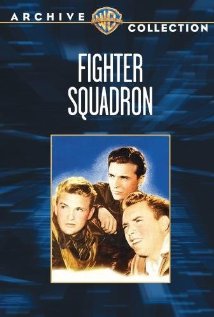
FIGHTER SQUADRON
US, 1948, 96 minutes, Colour.
Edmond O’ Brien, Robert Stack, John Rodney, Tom D’ Andrea, Henry Howell, Shepperd Strudwick.
Directed by Raoul Walsh.
Fighter Squadron is a 1948 film, one of those tributes to squadrons for their action during World War II, this time an American group, based in Britain, involved in bombings of Germany. There is very little to suggest how the Americans fitted into the British countryside, except with the entrepreneur Sgt, played by Tom D’ Andrea, who seems a very strong anticipation of Sgt Bilko.
The focus is on the flyers, the missions, the strict rules of combat by a conservative general and the openness of another general to experiment and take advice from the pilots themselves, especially about rescue attempts, of ditching fuel for lighter roads on return…
Edmond O’ Brien is the hardcase pilot, having served in China, not one to over-respect the rules until he is put in charge. Robert Stack is his friend who is in a dilemma about rules against getting married, causing split-second hesitations in bombing decisions. Henry Hull is the energetic open general while Shepperd Strudwick is the severe general.
Roald Walsh had been directing films for 30 years by this time, in silent films, in action films in the 1930s, at Warner Brothers in the 1940s and 50s, working into the 1960s.
In many ways it is a routine story, but given energy by the aerial sequences, in colour, and the incorporation of actual footage from war action.
1. 1940s war film, memories of World War II, tributes, seen in retrospect? The 21st century perspective?
2. The colour photography, the British locations, aerial action? The use of actual footage?
3. The bombing of Germany, the role of the British, the role of this American Squadron? Their hits, records, dangers, seeing them in detailed action, the pilots, the gunners, wounded, crashes, rescues?
4. The two generals, Mc Cready and his openness, energy? The contrast with Gilbert, by the book, cautious rules, the importance of obeying orders, suggesting court-martials, even for fighter aces?
5. Harden, his background, in China, freelancer, in the war, bombing raids, his risks, rescuing people? His friends, especially Hamilton? His obeying orders, disobeying orders, discussions with Gilbert, with McCready? His friend’s promotion? Being suggested for command? His accepting? His having to be strict with the men, a stickler for rules, yet his requests to the general, the changes of method?
6. Hamilton, friendship, easy-going, his fiancee, wanting to go home, submitting his resignation, the clash with Harden, returning, on the mission, his death?
7. The portrait of the other pilots, camaraderie, scenes in the mess together, friendships, supporting each other? The new pilot and his supporting Harden?
8. D- Day, the involvement, the troops on sea and land, giving information to bomb particular areas to protect those on shore, the intervention by the Germans – and not understanding who the Dodgers were?
9. The Sargeant, mischief, the entrepreneur, his schemes, changing his name as he went about the country getting rid of the black cat, with the women, the complaints, identifying him in the photo? His assistant and his putting him down yet promising anything? Finally in prison?
10. The final tributes to the men and their achievement and the contribution to the war effort?